Journalist or terrorist? Palestinian’s death at Gaza border a year ago still unresolved

- Share via
Reporting from Gaza City — About a year ago, on April 5, 2018, Yasser Murtaja, a 30-year-old photographer living and working in the Gaza Strip, took his drone-mounted camera and set out for the tiny enclave’s border with Israel to take some aerial shots in anticipation of major protests scheduled for the next day.
Facing mounting economic pressure and a restive population of about 2 million, Hamas — the militia governing the territory — early last year called on Palestinians to gather along Gaza’s border with Israel every Friday for what it termed the Great March of Return. The first of the demonstrations took place on March 30 of last year.
On Friday, April 6, the day of the second protest, Murtaja donned his dark-blue bulletproof vest marked “PRESS” on top of his street clothes and headed to the dusty boundary area to cover the march.
Shortly after noon, in bright daylight, working in a cloud of tear gas and in the midst of thousands of largely peaceful protesters, and among an estimated few hundred violent rioters, Murtaja was struck in the abdomen by a bullet shot by Israeli army snipers from across the divide.
“We were all together,” Rushdi Sarraj, his close friend and business associate, remembered in an interview with The Times. “Each one of us was following a particular scene or incident with their camera. Suddenly, we heard people yelling, ‘A journalist was wounded!’”
When he found Murtaja, Sarraj said, “he was lying down in agony, wearing his reporter’s vest.”
About 12 hours later, Murtaja was declared dead, the first journalist killed in protests that have gone on for a year, in which close to 200 Gazans have been killed in clashes with the Israeli army.
A year later, Murtaja’s story appears to be at a dead end.
After announcing it would investigate the circumstances of his death in response to an international outcry, the Israel Defense Forces (IDF) has gone silent.
Asked about the 11-month-old investigation, a spokesman for the Israeli army replied that “the matter of Yasser Murtaja is being examined by the General Staff Fact Finding Assessment Mechanism. When the probe concludes the data will be transmitted to the Military Advocate General’s Office.”
In a statement April 7, 2018, the Israeli army said it “does not intentionally shoot at journalists”and that “the circumstances in which the journalist was allegedly hit by IDF gunfire are unknown and under investigation.”
Yet almost immediately, even before a probe could be launched, Israeli officials began claiming, with no evidence, that Murtaja was a Hamas militant.
Nearly 1,000 Palestinians injured in Gaza-Israel border protests »
Murtaja and Sarraj never planned on becoming journalists.
Murtaja, who studied accounting, and Sarraj, an engineer, loved photography.
While still in their 20s, they launched a Facebook page titled Ain Ala Gaza (Eye on Gaza) as a platform for the lives they documented as residents of the beleaguered Gaza Strip.
“That hobby brought us together,” Sarraj, now 35, recalls. “And our passion kept evolving. We used to film all the time and we were always up to date when it comes to filmmaking.”
Eventually, in 2012, the pair decided to turn their pastime into a business, calling their enterprise Ain Media.
At first, they shared a single camera. But within four years Ain Media had acquired high-end equipment, orders from international press organizations and hired 15 employees.
In March 2018, the U.S. State Department had sent Ain Media a letter informing them that it had been awarded a United States Agency for International Development (USAID) grant of $11,700 for equipment and technical assistance.
Sarraj said the award, meant to help Ain Media establish a graphics department, was granted under the auspices of USAID’s Compete project, a program which helped develop the Palestinian private sector — and which was canceled by the Trump administration during the past year as part of its withdrawal of all U.S. aid to Palestinians.
On March 24, 2018, an ebullient Murtaja posted an aerial shot of Gaza City’s port on his Facebook page, writing, “I wish that the day would come to take this shot when I’m in the air and not on the ground. My name is Yaser Murtaja. I’m 30 years old. I live in Gaza City. I’ve never traveled!”
Murtaja, married and the father of a 2-year-old boy, never left Gaza, a 140-square-mile seaside territory that has been under an Israeli-Egyptian blockade since 2007, when the Islamist militia Hamas wrested control from the Palestinian Authority in a bloody coup.
On April 8, the day after Murtaja’s death, Israel’s then-Defense Minister Avigdor Lieberman said, “We have seen dozens of cases of Hamas activists disguised as medics and journalists. We also saw a journalist approach the border and operate a drone, we do not take chances in those cases.”
“In the march of terror there were no innocent civilians,” Lieberman said. “They were all Hamas.”
Murtaja and Sarraj occasionally used drones for some of their work, including film for the BBC and images used in a documentary by the Chinese artist Ai Weiwei. But, according to Sarraj, Murtaja left the drone in the office on April 6, the day he was shot.
On April 10, David Keyes, then a spokesman for Israeli Prime Minister Benjamin Netanyahu, tweeted, “Turns out the ‘photographer’ killed in Gaza was an officer in Hamas, a terrorist org that seeks Israel’s destruction. On Hamas’ payroll since 2011. Used his drone to collect intel on Israeli positions. Countless reporters called him a “journalist.” Will they correct the record?
On April 12, Israeli army spokesman Lt. Col. Jonathan Conricus said in a statement that Murtaja was “an officer at the equivalent rank of a captain in the security forces of the Hamas terrorist organization.”
“According to the intelligence in our possession, he was active in the Hamas security forces and supported their activity on a daily basis, including during the last days prior to his death.”
Murtaja’s family and colleagues categorically deny he had any ties to Hamas.
The State Department grant was authorized only after Ain Media successfully navigated stringent U.S. government vetting requirements before consideration for USAID-funded aid programs.
A few weeks after Murtaja’s death, Netanyahu spokesman Keyes told The Times, “[A]s for his connection to Hamas, you can quote me: Murtaja was 100% a Hamas officer. I saw the intelligence myself. There is not a scintilla of doubt.”
He and other Israeli officials declined to produce or describe the evidence against Murtaja.
In August, Ofir Gendelman, another spokesman for Netanyahu, told The Times, “We have been clear from the start that Murtaja was an officer of the al-Qassam Brigade and served there for years. He was not a journalist.”
The Izzidin al-Qassam Brigade is the official name of Hamas’ armed branch.
In an exchange of written messages with The Times, Gendelman said that Hamas lies outright “when it serves their PR purposes,” adding, “they say that members of their armed wing are innocent civilians and hope that unaware journalists buy this lie. Murtaja was a captain in Hamas.”
Almost a year after Murtaja’s death, Israel has yet to address the circumstances in which he died. The authorities have not substantiated the claim that he used a drone and have not presented or otherwise explained any evidence linking Murtaja to any terror organization.
The State Department declined to comment.
Sarraj is convinced that Israeli snipers targeted Murtaja specifically, shooting at him with an explosive bullet, and that the army is intentionally not investigating the incident.
“A year has passed and there has been no official professional investigation made regarding his death. Until now,” he says, “the Israeli army continues to target Palestinian journalists everywhere.”
Special correspondents Tarnopolsky and Abu Alouf reported from Ashkelon, Israel, and Gaza City, respectively.
More to Read
Sign up for Essential California
The most important California stories and recommendations in your inbox every morning.
You may occasionally receive promotional content from the Los Angeles Times.










